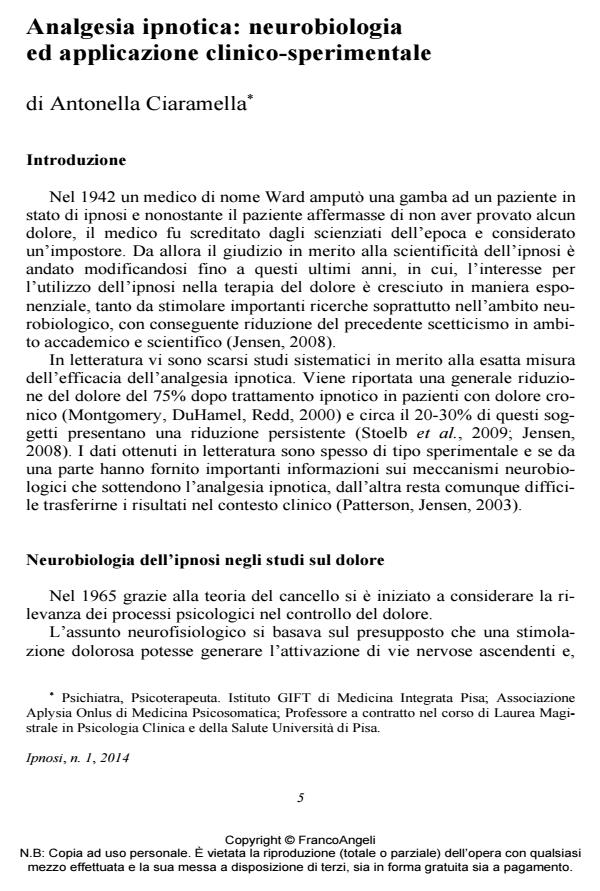Analgesia ipnotica: neurobiologia ed applicazione clinico-sperimentale
Journal title IPNOSI
Author/s Antonella Ciaramella
Publishing Year 2014 Issue 2014/1
Language Italian Pages 16 P. 5-20 File size 99 KB
DOI 10.3280/IPN2014-001001
DOI is like a bar code for intellectual property: to have more infomation
click here
Below, you can see the article first page
If you want to buy this article in PDF format, you can do it, following the instructions to buy download credits

FrancoAngeli is member of Publishers International Linking Association, Inc (PILA), a not-for-profit association which run the CrossRef service enabling links to and from online scholarly content.
After an exam of the neurobiological mechanisms of hypnotic analgesia, the author deepens indications and hypnotic techniques used in the treatment of chronic pain. A major emphasis is given to the relationship between hypnotic susceptibility and efficacy of hypnotic analgesia and, in this context, the author explains some results of neurobiological and clinical literature. Besides, the author shows some results of its clinical experience through the application of a protocol called: The "Structured Phenomenological Hypnotic Protocol" (SPHP).
Dopo una disamina dei meccanismi neurobiologici dell’analgesia ipnotica, in questo lavoro l’autore si sofferma sulle indicazioni e sulle tecniche ipnotiche utilizzate nella terapia del dolore. Un’importante rilevanza viene data alla relazione tra suscettibilità ipnotica ed efficacia dell’analgesia ipnotica; l’autore infatti ne fa una disamina riportando alcuni risultati della letteratura neurobiologica, clinica e descrivendo alcuni risultati della propria esperienza clinico-sperimentale mediante l’applicazione di un protocollo chiamato: The "Structured Phenomenological Hypnotic Protocol" (SPHP).
Keywords: Hypnosis, pain, hypnotic susceptibility, neurobiology, hypnosis phenomenology, analgesia
- Placebo and hypnosis in the clinical setting: Contextual factors in hypnotic analgesia Antonella Ciaramella, in American Journal of Clinical Hypnosis /2022 pp.223
DOI: 10.1080/00029157.2021.1954872 - Hypnotic analgesia in chronic pain: role of psychopathology and alexithymia Antonella Ciaramella, in American Journal of Clinical Hypnosis /2023 pp.299
DOI: 10.1080/00029157.2022.2161868
Antonella Ciaramella, Analgesia ipnotica: neurobiologia ed applicazione clinico-sperimentale in "IPNOSI" 1/2014, pp 5-20, DOI: 10.3280/IPN2014-001001